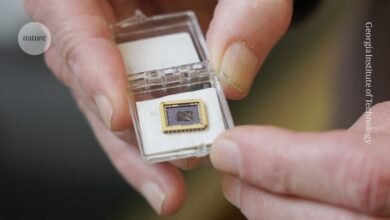Translation selectively destroys non-functional transcription complexes
Proteins and nucleic acids
Wild-type E. coli core RNAP was expressed from PVS10 plasmid coding for all five subunits28 and purified as described29. E. coli RNAP lacking the Trigger Loop was from our previous study20. The 70S ribosomes, EF-G, EF-Tu, EF-Ts, IF1-3, formyl methionine transferase, methionyl-tRNA synthetase and RelE were purified as described in ref. 7. Other individual aminoacyl-tRNA-synthetases were cloned and purified as described for methionyl-tRNA synthetase7. Aminoacylation of tRNAs and formylation of Met-tRNAfMet were performed as described7, except for the use of individual aminoacyl-tRNA-synthetases in place of S100. Mixtures for translation elongation containing individual ternary complexes were prepared using 80 pmol of aminoacyl-tRNAs, 200 pmol of EF-Tu and EF-Ts, 150 pmol of EF-G, 4 mM GTP in 17 μl of coupling buffer (CB; 25 mM Tris-HCl pH 7.4, 60 mM NH4Cl, 10 mM Mg(OAc)2, 6 mM β-mercaptoethanol). Mfd30, UvrD31, RapA32, NusG and NusA7 were all cloned in pET28a coding for N-terminal 6xHis-tag, purified as described in references, with His-tag subsequently removed by thrombin (Sigma-Aldrich) cleavage as per the suppliers’ instructions. SDS gels of all purified proteins are shown in Extended Data Fig. 9a. Oligonucleotides came from IDT, except for the pyrimidine-dimer (T=T) template from Gene Link. mRNAs were synthesized using T7 RNAP and 32P-radiolabelled at the 5′ end as described in ref. 7. Oligonucleotides and mRNA sequences are shown in Extended Data Fig. 1.
EC assembly
The in vitro coupled system for a 20-reaction experiment was assembled as follows: 50 pmol of template DNA and 30 pmol of mRNA were annealed in 22 μl of CB (25 mM Tris-HCl pH 7.4, 60 mM NH4Cl, 10 mM Mg(OAc)2, 6 mM β-mercaptoethanol), followed by addition of 50 pmol RNAP and then 110 pmol of non-template DNA oligo at 37 °C. ECs were immobilized on 5 µl of streptavidin-Sepharose beads (Cytiva) equilibrated in CB. The system was washed with CB + 1 M KCl and then with CB. The EC was then walked to the desired location on the template with sets of 10 µM NTPs for 3 min per each step (shown in Extended Data Fig. 1 for all ECs) and washing with CB between the steps. For most of the experiments, lesion was reached in one step by addition of CTP (cytidine triphosphate), UTP (uridine triphosphate) and GTP simultaneously. For formation of stably backtracked EC, 1 mM NTPs were added to the EC formed on the template without DNA lesion (Extended Data Fig. 1a) for 5 min. This results in the EC reaching the streptavidin bead, which leads to stable backtracking, as described in ref. 7. Then 4 mM GTP was used for misincorporation in place of AMP at the 3′ end of mRNA paused on the template without lesion (Extended Data Fig. 1a). For all reactions, ECs were thoroughly washed with CB and the reaction volume was adjusted to 10 μl. For assessment of translocation state of stalled ECs, 5 pmol of GreA or GreB or 500 µM pyrophosphate (PPi) were added at 37 °C for times indicated in Extended Data Fig. 1b. For the salt stability test, the reaction was transferred to CB + 1 M KCl and left for 10 min at room temperature before separation of supernatant and beads fractions and analysis as described below.
Coupled transcription–translation
Translation was initiated on the mRNA of the ECs by addition of 20 μl of CB containing 200 pmol of ribosomes, 200 pmol of fMet-tRNAfMet, 200 pmol of each of IF1-3 and 4 mM GTP at 37 °C for 8 min. The coupled system was washed with CB, volume adjusted to 25 μl and separated into 5 μl of reactions. Where indicated, the reactions were supplied with 5 pmol of a factor (NusA and NusG, RapA or UvrD) in 3 μl of CB for 2 min at 37 °C. RapA and UvrD reactions also contained 2 mM dATP (final concentration). Translation elongation was started with 17 μl of corresponding elongation mixture of ternary complexes with EF-G/GTP (above). Where indicated, 100 µM NTPs or 400 µM streptolydigin (final concentrations) were added simultaneously with translation elongation mixture. Reactions were allowed to proceed for 4 min at 37 °C. Beads were separated from supernatant. After that, beads were washed with 1 ml of CB and volumes of beads and supernatant fractions were adjusted to 21 μl each. Then 5 µl samples were taken for challenge with 20 pmol of RelE for 5 min at 37 °C or 5 pmol of GreB for 30 s at 37 °C. Reactions were mixed with the equal volume of formamide and EDTA containing buffer. Products were resolved in 10% denaturing (8 M urea) polyacrylamide gel, revealed using phosphorimaging (Cytiva) and analysed using ImageQuant software (Cytiva). The method of quantification of EC dislodging is explained in Extended Data Fig. 9b. Quantitation in figures shows means ± s.d.s from at least three independent experiments. Relevant P values are shown above or next to the histograms. Plots were generated using ggplot2 and statistical analyses shown were performed using stat_compare_means (Student’s t-test) in RStudio (v.2022.07.2).
Challenging coupled system with Mfd
For the experiment with Mfd, an EC with longer upstream DNA duplex was used (Extended Data Fig. 1a). The ribosome was allowed to elongate by only F and V codons, thus stopping the ribosome at the minimal distance from the EC stalled at the T=T lesion (25 nts between the active centres of ribosome and RNAP; Extended Data Fig. 1a). The coupled system was washed and volume adjusted as above, and 5 pmol of Mfd and 2 mM ATP were added for 3 min at 37 °C. Beads and supernatant fractions were separated and analysed as above.
Challenging stalled ECs with trailing EC
Stalled ECs were obtained as above on the nucleic acids scaffold shown in Extended Data Fig. 1e. After washing, 25 pmol of second (trailing) 5′-radiolabelled RNA transcript were added for 5 min at room temperature, followed by addition of 50 pmol RNAP. Complexes were washed with CB and supplied with 20 µM NTPs for 5 min. Supernatant and beads fractions were separated and analysed as above.
EC preparation for cryo-EM
For cryo-EM, nucleic acids shown in Extended Data Fig. 1a were used, except the non-template strand, which contained a UV-photocleavable group at the biotin end (IDT) allowing for elution from beads. The ECs were prepared in two batches starting with the annealing of 50 pmol of mRNA and 50 pmol of template DNA in 15 µl of CB, followed by the addition of 60 pmol of RNAP for 5 min and 150 pmol of non-template DNA for five further minutes. The ECs were immobilized on 12 µl of streptavidin bead slurry and washed with CB + 1 M KCl and then CB. The ECs were walked to the T=T lesion using 20 µM GTP, CTP and UTP (final concentration) followed by CB washes. 20 µM ATP was added for 3 h. Volumes of reactions were adjusted with CB to 50 µl. Stalled ECs were eluted from the beads by exposure to 365 nm light of the lamp BDH VL-206BL (Vilber-Lourmat) equipped with T-6L light tubes for four rounds of 30 s. Supernatants were joined and concentrated to 25 µl on Amicon-50 0.5 ml filter (Merck Millipore).
Cryo-EM grid preparation
UltrAuFoil300 R1.2/1.3 holey gold grids (Quantifoil) were positively glow-charged using an EasyGlow Discharge System (PELCO) at 25 mA for 4 min at 0.26 mBar. This was followed by three applications of 3.5 µl of eluted ECs using a Vitrobot Mark IV (FEI) with 100% chamber humidity at 4 °C, before plunge-freezing into liquid ethane.
Cryo-EM data acquisition and processing
The workflow and statistics of cryo-EM analysis are shown in Extended Data Fig. 7a and Extended Data Table 1, respectively. Grids were imaged using a Glacios cryo-TEM (Thermo Scientific), with a Falcon 4 electron detector (Thermo Scientific), at the York Biostructure Laboratory (York University). A total of 16,264 videos were recorded in EPU (Thermo Scientific) with a nominal magnification of ×240,000 and pixel size of 0.574 Å/pix with a defocus range of −0.8 to −2.0 µM. Data were collected with a 6.4 s exposure, 1,574 subframes (total frames) and dose per frame of 0.03246 electrons per Å2 to give a total dose of 50 electrons per Å2.
Videos were motion corrected using motioncorr2 (ref. 33) before estimation of the contrast transfer function (CTF) with CTFFIND4 (ref. 34), in RELION35. These videos were also motion corrected and had CTF estimated using cryoSPARC implementations36 to allow use of iterative cryoSPARC two-dimensional (2D) particle sorting algorithms starting with an initial blob pick using a 100–300 pixel box range and 15 Å lowpass filtered micrograph images, finding 2,431,144 particles. The final 160,183 particles were transferred from cryoSPARC and extracted in RELION with a box size of 500 pixels, 5 × 5 binned to 100 pixels with a pixel size of 2.87 Å/pix and subject to several rounds of further 2D classification and particle selection. The 143,018 particles from the final selection of 2D classification were then used to generate an initial model through a RELION gradient-driven algorithm with a 250 Å mask diameter. This initial model was converted and upscaled using the RELION command line image handler to a box size of 500 pixels with a pixel size of 0.574 Å/pix, while the particles were re-extracted with the same box and pixel sizes. The particles were then subjected to three-dimensional (3D) classification enabling the further removal of junk particles, leaving 131,098 particles for 3D auto refinement. The refined map was then postprocessed to 3.1 Å before advanced particle processing using CTF refinement and Bayesian polish jobs. The subsequent final 3D refinement and postprocessing was carried out with a soft mask of the entire EC, resulting in a final map resolution of 2.87 Å, as reported by RELION.
Model building and refinement
An initial model was rigid fit to the final map in ChimeraX (UCSF) using the cryo-EM data-generated model of the E. coli RNAP EC37 (Protein Data Bank (PDB) ID 8FVR). This model was then subjected to real space refinement in phenix38 and manual editing in COOT39. The T=T lesion was built in place of template DNA residues as a ligand using a T=T lesion from a T7 RNAP stalled at the T=T lesion40 (PDB ID 1SL2). Extra DNA and RNA extensions to the main chains were completed in Coot, before further cycles of refinement and processing in phenix and Coot. Point spread function resolution (Extended Data Fig. 7c) was calculated using cryoEF41.
Reporting summary
Further information on research design is available in the Nature Portfolio Reporting Summary linked to this article.
Source link



